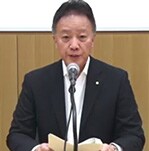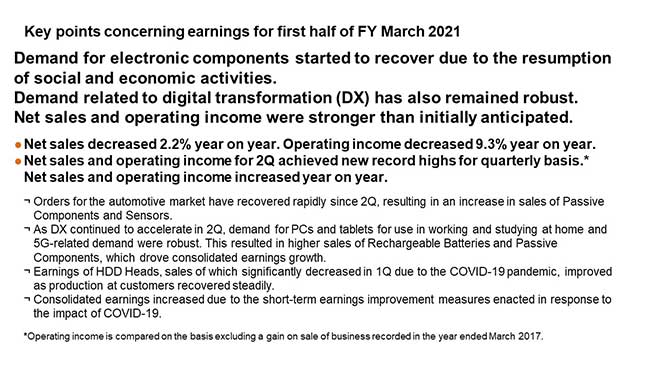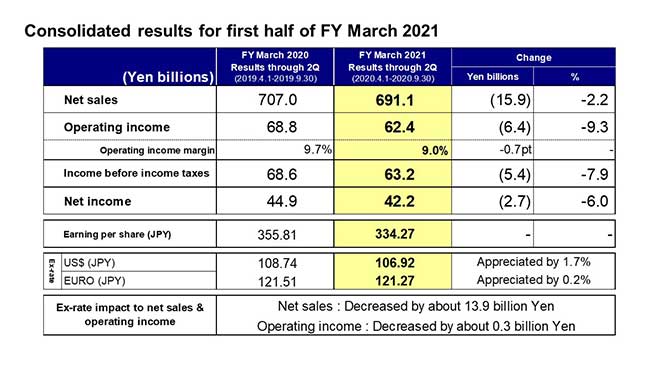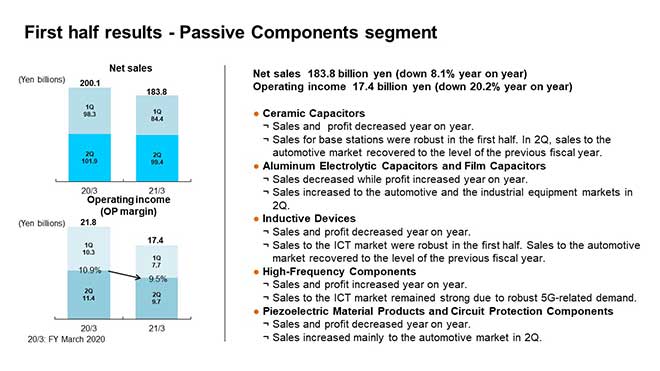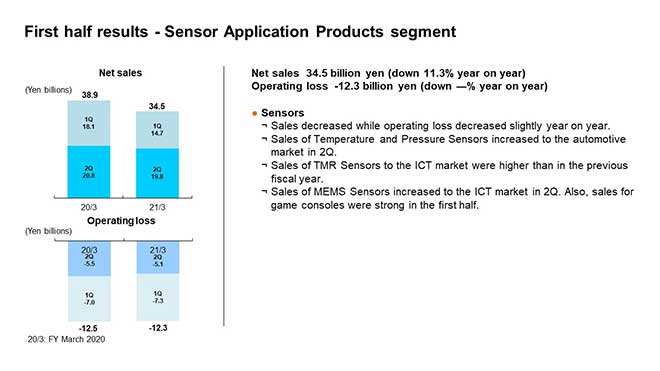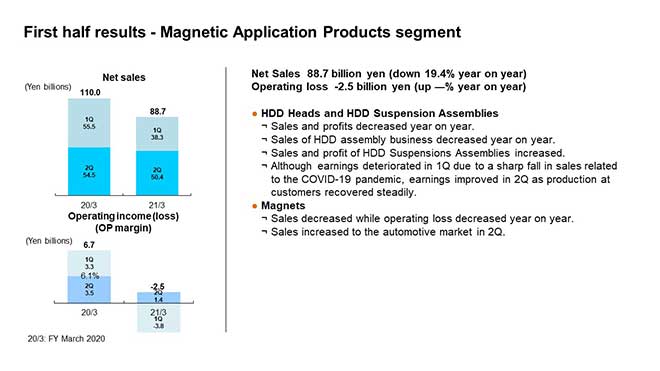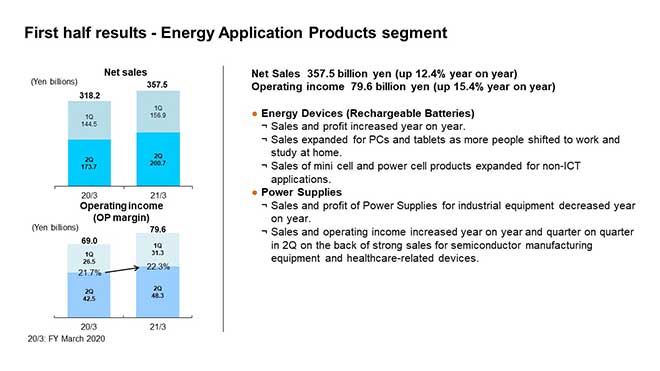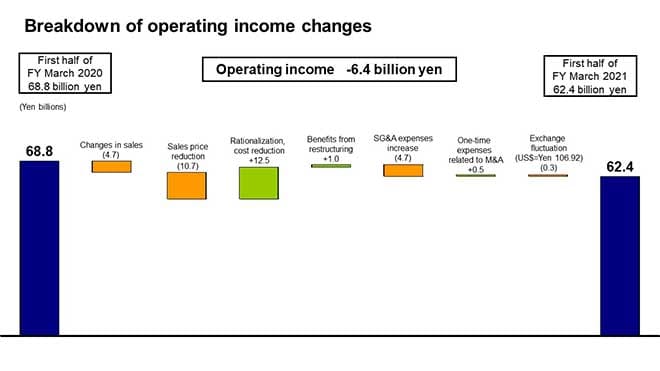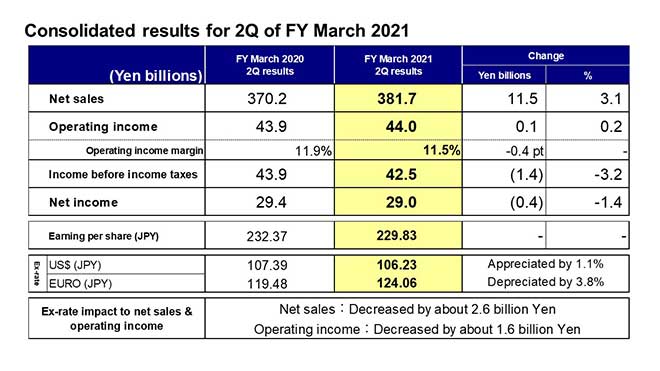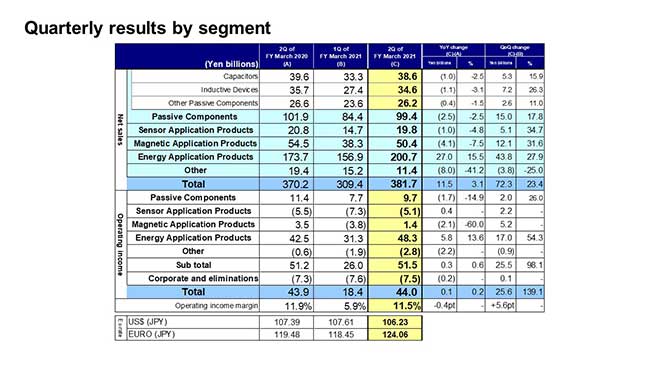[ 2nd Quarter of fiscal 2021 Performance Briefing ]Consolidated Results for First Half of FY March 2021
Mr. Tetsuji Yamanishi
Executive Vice President
Hello, I am Tetsuji Yamanishi, Executive Vice President of TDK. Thank you for taking the time to attend TDK’s performance briefing for the first half of the fiscal year ending March 2021. I will be presenting an overview of our consolidated results.
Key points concerning earnings for first half of FY March 2021
First, let’s take a look at the key points concerning the earnings for the first half. As we entered the second quarter, lockdowns began to be lifted in different countries around the world, resulting in a gradual resumption of social and economic activities and full-scale production activities at customers. This led to a clearer recovery trend in electronics demand. Although demand saw a huge decline in the automotive market and the HDD market, which were significantly affected by the suspension of production in the first quarter, it substantially recovered in the second quarter. In the ICT market, an increase in people working at home and taking classes online caused a sudden acceleration in digital transformation (DX) in the first quarter, with mobile device- and 5G-related demand increasing more than initially anticipated. This momentum remained robust in the second quarter, resulting in both net sales and operating income for the first half significantly surpassing initial expectations.
As a result, we posted record levels of quarterly net sales and operating income for the second quarter and achieved a year-on-year increase in sales and profit, although net sales and operating income for the first half decreased by 2.2% and 9.3%, respectively, on a year-on-year basis due to the impact of lockdowns in the first quarter.
Orders in the automotive market recovered rapidly in the second quarter, resulting in an increase in sales of Passive Components such as MLCCs and Inductors, as well as Sensors. Furthermore, the continued acceleration of DX led to robust demand for related products and boosted sales of Rechargeable Batteries and Passive Components, including High Frequency Components. These contributed significantly to the overall earnings of the Company.
HDD Heads, which were hard hit by the suspension of plant operations by a major customer in the first quarter, saw earnings improve as production at the customer resumed steadily.
Furthermore, we made solid efforts to make up for the expected deterioration of business performance through additional earnings improvement measures formulated at the beginning of the fiscal year by carrying out rationalization, etc. to provide against the decline in operating performance due to the COVID-19 pandemic. This yielded results beyond initial expectations and, along with an expansion of sales, made a huge contribution to boosting earnings.
Consolidated results for first half of FY March 2021
Moving along, I would like to present an overview of our results. The yen's appreciation against the U.S. dollar and other currencies caused net sales to contract by around 13.9 billion yen and operating income to decrease by around 0.3 billion yen. Including this impact, net sales were 691.1 billion yen, a decrease of 15.9 billion yen, or 2.2%, year on year. Operating income was 62.4 billion yen, down 6.4 billion yen, or 9.3%, year on year. Income before income taxes was 63.2 billion yen, net income was 42.2 billion yen, and earnings per share were 334.27 yen.
With regard to exchange rate sensitivity, we maintain our estimate that a change of 1 yen against the U.S. dollar will affect annual operating income by about 1.2 billion yen, while a change against the euro will have an impact of about 0.2 billion yen.
First half results - Passive Components segment
Next, I would like to explain our business segment performance for the first half. In addition to year-on-year comparisons of first half results, I will explain the year-on-year as well as quarter-on-quarter changes in our second quarter earnings, as the demand environment changed dramatically between the first and second quarters of this year.
In the Passive Components segment, net sales for the first half declined 8.1% year on year to 183.8 billion yen, operating income decreased 20.2% to 17.4 billion yen, and the operating income margin was 9.5%. In terms of second quarter results, net sales declined 2.5% year on year, operating income decreased 14.9%, and the operating income margin was 9.8%.
As demand in the automotive market saw a rapid recovery and 5G-related demand remained robust in the ICT market during the second quarter, net sales and operating income increased significantly from the first quarter, by 17.8% and 26.0%, respectively.
On a first half basis, sales and profit for High Frequency Components increased, as they continued to capture 5G-related demand. Aluminum Electrolytic Capacitors and Film Capacitors saw an increase in profit due to cost reduction, despite a decline in sales. However, sales and profit of other products declined due to the drop in orders in the automotive market in the first quarter.
I would now like to explain each product’s quarter-on-quarter change in performance. In Ceramic Capacitors, overall sales increased due to the recovery of automobile demand, despite a drop in sales for 5G base stations. However, operating income decreased as inventory that was increased strategically in the first quarter was drawn down. Second quarter sales to the automotive market recovered to the level of the previous year’s second quarter. In Aluminum Electrolytic Capacitors and Film Capacitors, sales and profit increased due to a rise in sales to the industrial equipment market, in addition to the automotive market. Sales recovered to the level of the second quarter of the previous year. In Inductive Devices, sales increased significantly from the first quarter due to a recovery in demand from the automotive market, an increase in demand from the ICT market on the back of the strong launch of a new smartphone product, and a rise in demand from the industrial equipment market. Operating income also increased despite the impact of the consumption of inventory. Sales to the automotive market recovered to the level of the previous year’s second quarter, as in Ceramic Capacitors. In High Frequency Components, sales and operating income maintained the levels of the first quarter on the back of robust 5G-related demand. In Piezoelectric Material Products and Circuit Protection Components, sales and profit increased in the overall automotive, ICT and industrial equipment markets, while sales to the automotive market fell below last year’s levels.
First half results - Sensor Application Products segment
In the Sensor Application Products segment, net sales decreased 11.3% year on year to 34.5 billion yen in the first half, while operating loss decreased slightly.
Net sales in the second quarter increased 34.7% quarter on quarter, due to a rise in demand from the automotive market, an increase in sales for smartphone applications on the back of the strong launch of a new model in North America, and an increase in sales to a major Chinese customer. Operating loss decreased by 2.2 billion yen quarter on quarter and by 0.4 billion year on year, despite a 4.8% drop in sales.
On a first half basis, sales and profit decreased in Temperature and Pressure Sensors as well as in Hall Sensors due to the large impact of weak demand from the automotive market in the first quarter mainly for conventional sensors. Sales of MEMS Sensors also decreased due to a drop in demand for Microphones for IoT devices on the back of a decline in consumer sentiment in the face of the coronavirus pandemic, and to a decrease in the number of smartphone models in which Motion Sensors are installed. Operating loss continued, albeit on a decreasing trend, as sales failed to increase sufficiently. Meanwhile, TMR Sensors saw a significant increase in sales and profit on the back of robust sales for use in smartphones as market share increased.
I would now like to explain quarter-on-quarter changes. Temperature and Pressure Sensors saw an increase in sales as sales to the automotive market rose, and have become able to contribute to earnings, although a small operating loss remains. Sales of Hall Sensors remained flat quarter on quarter as orders failed to see a full recovery due to the long supply chain for the automotive market. Sales of conventional sensors to the automotive market failed to recover to the level of the previous year’s second quarter. In TMR Sensors, sales and operating income increased substantially on the back of the strong launch of a new smartphone model, while sales and profit also rose significantly on a year-on-year basis. In MEMS Sensors, sales increased due to a rise in sales to a major Chinese smartphone manufacturer, despite a quarter-on-quarter drop in orders for use in game consoles. Operating loss decreased due to cost reductions.
First half results - Magnetic Application Products segment
In the Magnetic Application Products segment, net sales decreased 19.4% year on year to 88.7 billion yen and operating income/loss ended at an operating loss of 2.5 billion yen for the first half.
In the second quarter, HDD Heads, hit hard by the suspension of operations by a major customer in the first quarter, saw a recovery in sales, HDD Suspension Assemblies saw an increase in sales for use in Nearline HDDs, and Magnets also saw a rise in sales due to a recovery of demand from the automotive market. In the Magnetic Application Products segment as a whole, sales increased 31.6% quarter on quarter and the operating loss in the first quarter improved to an operating profit.
On a first half basis, sales of HDD Heads decreased substantially, leading to a deterioration in earnings, as HDD Head shipment volumes fell and sales of the HDD assembly business decreased due to a decline in the overall demand for HDDs. Meanwhile, HDD Suspension Assemblies saw increases in both sales and profit due to a rise in shipment volumes on the back of robust sales for Nearline HDDs of a major customer. In Magnets, sales decreased due to an insufficient recovery in sales to the automotive and industrial equipment markets, while profit improved due to rationalization.
I would now like to explain quarter-on-quarter changes. Sales and profit of HDD Heads increased significantly on the back a rise in the shipment index from 55 in the first quarter to 91 in the second quarter. HDD Suspension Assemblies also saw a rise in sales due to an increase in orders for Nearline HDD applications of a major customer and an increase in sales of the profitable, small μDSA products. Magnets saw a rise in sales due to an increase in sales to the automotive market, while operating loss remained flat.
First half results - Energy Application Products segment
In the Energy Application Products segment, both net sales and operating income for the first half rose significantly by 12.4% and 15.4% year on year respectively, to 357.5 billion yen and 79.6 billion yen, respectively. Profitability also improved, as the operating income margin rose to 22.3%.
In the second quarter, sales of the segment increased on the back of continued strong sales of Rechargeable Batteries and a rise in demand for semiconductor manufacturing equipment applications in Power Supplies. As a result, sales and profit of the segment as a whole rose 27.9% and 54.3% quarter on quarter, respectively. They also rose 15.5% and 13.6%, respectively, on a year-on-year basis.
On a first half basis, overall sales and profit increased substantially due to a growth in sales for use in PCs and tablets and the start of full-scale sales of power cells for residential energy storage systems and e-drives. This was despite a small fall in sales for use in smartphones due to a decrease in smartphone production. Meanwhile, Power Supplies saw slight falls in both sales and profit.
I would now like to explain quarter-on-quarter changes. In Rechargeable Batteries, sales increased as demand for use in smartphones rose substantially due to the peak season and sales for use in PCs and tablets also continued to increase quarter on quarter. Sales and profit also increased on a year-on-year basis. In Power Supplies, sales and profit increased on the back of a rise in demand for industrial equipment applications.
Breakdown of operating income changes
Next is the breakdown of the change in operating income. Let’s take a look at the main factors behind the 6.4 billion yen decrease in operating income. First, there was a decrease in income of about 4.7 billion yen due to the decrease in sales volume of Passive Components and HDD Heads, despite growth in sales of Rechargeable Batteries. Reductions in sales prices had a negative impact of about 10.7 billion yen. On the other hand, there was a positive impact of about 12.5 billion yen from cost reductions from rationalization, including cost cuts undertaken to counteract profit deterioration due to the impact of COVID-19, along with benefits of about 1.0 billion yen from restructuring. We are working to strengthen our financial base. Expenses related to the InvenSense acquisition decreased by about 0.5 billion yen, while selling, general and administrative expenses (SG&A) increased by about 4.7 billion yen due to an increase in SG&A and development expenses in connection with the business expansion in Rechargeable Batteries and the cessation of a filter fee that TDK had been receiving up to the previous fiscal year. Exchange rate fluctuations had a negative impact of 0.3 billion yen. These resulted in an overall decrease in operating income of 6.4 billion yen.
Consolidated results for 2Q of FY March 2021
Next, let’s look at the consolidated results for the second quarter of the fiscal year ending March 2021.
In the second quarter of the fiscal year ending March 2021, net sales rose 3.1% year on year to 381.7 billion yen, operating income increased 0.2% to 44.0 billion yen, income before income taxes was 42.5 billion yen, and net income was 29.0 billion yen, setting new record highs for net sales and operating income on a quarterly basis.
Quarterly results by segment
I will explain some of the factors behind the changes in segment net sales and operating income from the first quarter to the second quarter of the fiscal year ending March 2021. I have already explained the changes in the Passive Components, Sensor Application Products, Magnetic Application Products, and the Energy Application Products segments, so here I will explain the major changes in the businesses included in Other.
Net sales of the Other segment for the second quarter were 11.4 billion yen, a 25.0% fall from the first quarter, and operating loss was 2.8 billion yen, a 0.9 billion yen increase of loss from the first quarter. The main factor for this decline was the deterioration of the earnings for micro-actuators, which are incorporated in smartphone camera modules. Our characteristic product for camera modules has enabled us to increase our share mainly for use in high-end smartphones of a major Chinese customer. However, earnings deteriorated as sales rapidly declined in the second quarter.
That concludes my presentation. Thank you very much for your attention.

